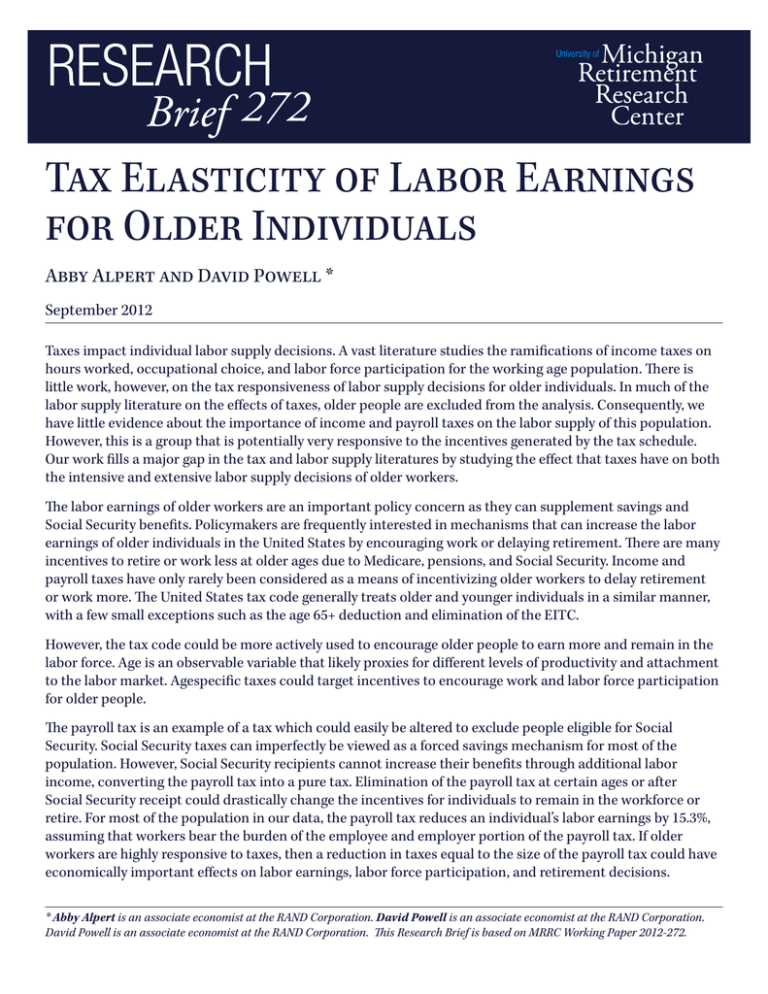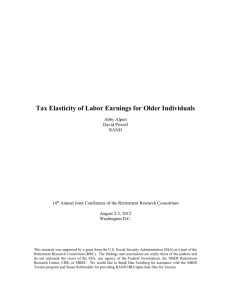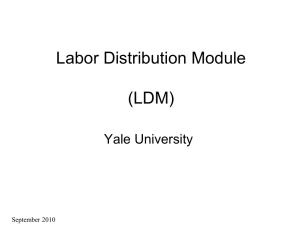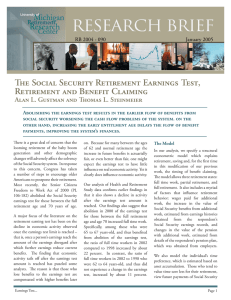Tax Elasticity of Labor Earnings for Older Individuals
advertisement

Tax Elasticity of Labor Earnings for Older Individuals Abby Alpert and David Powell * September 2012 Taxes impact individual labor supply decisions. A vast literature studies the ramifications of income taxes on hours worked, occupational choice, and labor force participation for the working age population. There is little work, however, on the tax responsiveness of labor supply decisions for older individuals. In much of the labor supply literature on the effects of taxes, older people are excluded from the analysis. Consequently, we have little evidence about the importance of income and payroll taxes on the labor supply of this population. However, this is a group that is potentially very responsive to the incentives generated by the tax schedule. Our work fills a major gap in the tax and labor supply literatures by studying the effect that taxes have on both the intensive and extensive labor supply decisions of older workers. The labor earnings of older workers are an important policy concern as they can supplement savings and Social Security benefits. Policymakers are frequently interested in mechanisms that can increase the labor earnings of older individuals in the United States by encouraging work or delaying retirement. There are many incentives to retire or work less at older ages due to Medicare, pensions, and Social Security. Income and payroll taxes have only rarely been considered as a means of incentivizing older workers to delay retirement or work more. The United States tax code generally treats older and younger individuals in a similar manner, with a few small exceptions such as the age 65+ deduction and elimination of the EITC. However, the tax code could be more actively used to encourage older people to earn more and remain in the labor force. Age is an observable variable that likely proxies for different levels of productivity and attachment to the labor market. Agespecific taxes could target incentives to encourage work and labor force participation for older people. The payroll tax is an example of a tax which could easily be altered to exclude people eligible for Social Security. Social Security taxes can imperfectly be viewed as a forced savings mechanism for most of the population. However, Social Security recipients cannot increase their benefits through additional labor income, converting the payroll tax into a pure tax. Elimination of the payroll tax at certain ages or after Social Security receipt could drastically change the incentives for individuals to remain in the workforce or retire. For most of the population in our data, the payroll tax reduces an individual’s labor earnings by 15.3%, assuming that workers bear the burden of the employee and employer portion of the payroll tax. If older workers are highly responsive to taxes, then a reduction in taxes equal to the size of the payroll tax could have economically important effects on labor earnings, labor force participation, and retirement decisions. * Abby Alpert is an associate economist at the RAND Corporation. David Powell is an associate economist at the RAND Corporation. David Powell is an associate economist at the RAND Corporation. This Research Brief is based on MRRC Working Paper 2012-272. In our work, we utilize the 2000–2008 Health and Retirement Study (HRS), a longitudinal data set of people ages 55 and above. We use the demographic and detailed income information in these data to derive tax variables with the NBER Taxsim program. Studying the impact of taxes on an older population faces an empirical challenge beyond those found in the existing tax literature. This is a population in which the decision to participate in the labor force or retire is an important component. Thus, it is critical to model and estimate the impact of taxes on both the intensive and extensive margins of labor supply. Individuals who are not working are likely different from individuals who are working and not accounting for their differences could bias our estimation of the impact of taxes. Our paper models intensive labor earnings as a function of the marginal net-of-tax rate — the fraction of an additional dollar in earnings that the individual keeps — and aftertax income. This is a standard approach in the tax and labor supply. We model the decision to participate in the labor force or retire as a function of the individual’s potential labor earnings net of the additional taxes that the individual would pay due to those labor earnings (i.e., the after-tax labor earnings). Understanding both of these dimensions of labor supply is critical for our estimates. Simply excluding non-workers from the intensive labor supply analysis assumes that the non-workers are not working for reasons unrelated to taxes. Similarly, estimating the impact of taxes on the decision to work requires knowledge of the amount that individuals would earn and pay in taxes if they participated in the labor force. In any analysis of the effect of taxes on individual behavior, researchers must also account for the mechanical relationship between taxes and earnings since a person’s tax rates and tax liability, in general, increase with earnings. We predict changes in taxes using legislative tax schedule changes and the different effect that these changes have on individuals because of their marital status. During the time period of our analysis, there were two major tax changes — the Economic Growth and Tax Reconciliation of 2001 and the Jobs and Growth Tax Relief Reconciliation Act of 2003. These reforms included marriage penalty relief provisions that affected joint filers, but not single filers. We use these differential changes to predict tax changes in our empirical strategy. Our empirical analysis finds potentially large effects on the intensive margin for workers aged 55 and over. However, due to the statistical imprecision of these estimates, we cannot reject the absence of an effect for men. For women, we find statistically significant and large effects on the intensive margin. Accounting for selection into working has an important impact on the point estimates. We find that older individuals are very responsive on the extensive margin in both a statistically and economically meaningful way. Our estimates suggest that the elimination of the employee portion of payroll taxes for the 55-74 population would decrease the percentage of workers dropping out of the labor force by 1 percentage point, a 4% decrease. We also find that taxes have a significant effect on the retirement decisions of men. Interestingly, we do not find similar retirement effects for women. University of Michigan Retirement Research Center Institute for Social Research 426 Thompson Street Room 3026 Ann Arbor, MI 48104-2321 Phone: (734) 615-0422 Fax: (734) 615-2180 mrrcumich@umich.edu www.mrrc.isr.umich.edu The research reported herein was performed pursuant to a grant from the U.S. Social Security Administration (SSA) through the Michigan Retirement Research Center (MRRC). The findings and conclusions expressed are solely those of the author(s) and do not represent the views of SSA, any agency of the federal government, or the MRRC. Regents of the University of Michigan: Julia Donovan Darlow, Laurence B. Deitch, Denise Ilitch, Olivia P. Maynard, Andrea Fischer Newman, Andrew C. Richner, S. Martin Taylor, Katherine E. White, Mary Sue Coleman, Ex Officio

![[Product Name]](http://s2.studylib.net/store/data/005238235_1-ad193c18a3c3c1520cb3a408c054adb7-300x300.png)



